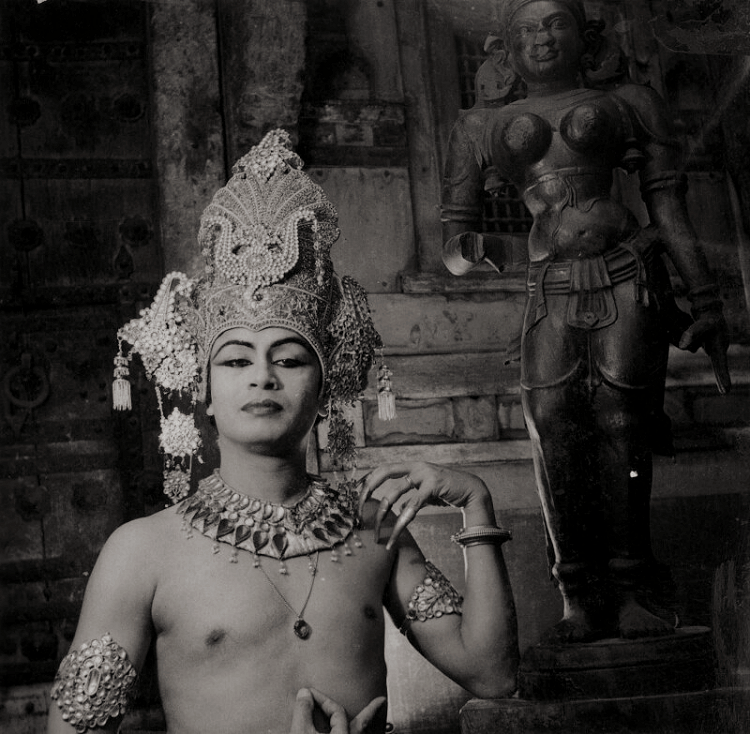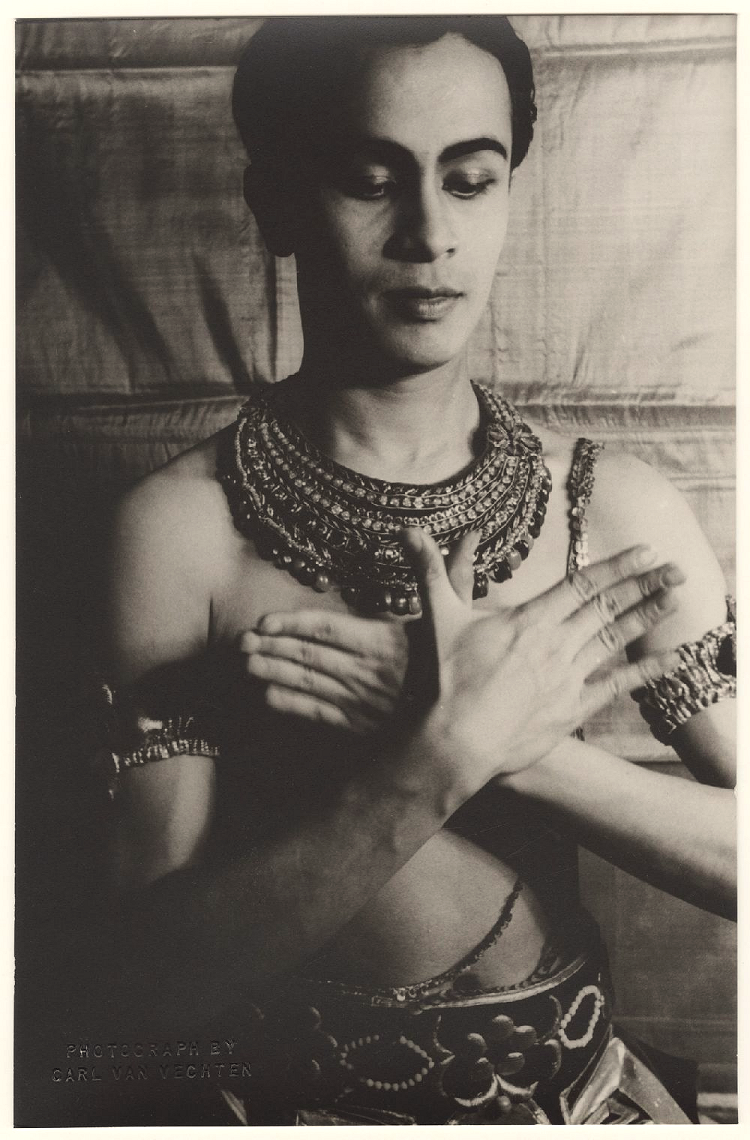 |
| Eight portraits by Carl Van Vechten, 1938. |
Bissano Ram Gopal OBE (20 November 1912, Bangalore – 12 October 2003, Croydon), Indian dancer, choreographer, and author who performed mostly as a soloist, touring extensively throughout a lengthy career. A modernist, he blended the classical Indian dance with balletic choreography and, beginning in the the 1930s, was among the first to showcase Indian classical dance in the West. As a choreographer, he is most known for his productions, Legend of the Taj Mahal, Dance of the Setting Sun, and Dances of India. Dance critic, Cyril Beaumont editor of Dance Journal, wrote of his dancing, "what impresses one most about Ram Gopal's dancing is the manner in which he is able to assimilate the characteristics of the four schools of technique so completely different in style, costume and mood." Another critic dubbed him "the Nijinsky of India."
 |
| Seven portraits by Van Vechten, 1938. |
Born the son of a Rajput barrister and a Burmese mother, he was drawn to dance from an early age. His grandmother was a well known dancer, herself, and once, without his disapproving father's permission, he danced at the annual garden party of the Maharaja of Mysore. Impressed, the Maharaja persuaded his father to allow him to receive further dance training and, while still in his youth, he began an intensive study of the various dance traditions of the subcontinent and, later, that of other parts of Asia, all of which would go on to inform his own choreography.
 |
| Six portrait by George Hurrell, 1938. |
Still in his early twenties, he was invited by the visiting La Meri, an American dancer who specialized in non-Western forms of dance, to tour with her through Asia. They traveled to Burma, Malaysia, Indonesia, Singapore, and then to Japan, where La Meri was infuriated that Tokyo's press gave its exclusive praise to her young protégé; she promptly abandoned him and left for other engagements. Devastated, he was fortunate to meet a Polish journalist and critic, Aleksander Janta-Połczyński, who became a sort of guardian and manager. (And if we read between the lines, probably more. Unfortunately, I haven't found any specific information on the dancer's amours.)
 |
| Seven portraits by Van Vechten, 1938. |
 |
| Aleksander Janta-Połczyński. |
 |
| With Aleksander Janta-Połczyński in costume. |
The two left for the United States, landing in San Francisco, then traveling through Hollywood, making important connections on their way to the east coast. An introduction to the impresario Sol Hurok by none other than Cecil B. DeMille led to the dancer's solo debut in New York City in May of 1938. The next year he was in Paris and then in London, where he attracted great acclaim, not only meeting Queen Mary, but making important connections with leading figures in ballet. He returned to India during World War II, working with ENSA. (Entertainments National Service Association - ENSA - was an organization formed in 1939 to provide entertainment for British armed forces personnel during the war.)
 |
| Six portraits by Van Vechten, 1938. |
He recommenced touring after the war, as a soloist and with his company, performing theatrically and in dance festivals, performances that were noted for their attention to costumes, staging, and lighting. He also frequently collaborated with other dancers and dance troupes. Perhaps most famously, in 1960 he collaborated with ballerina Dame Alicia Markova to create the duet Radha-Krishna. Based on Hindu mythology, Markova danced the role of Radha, while he danced as Krishna.
 |
| Eight portraits by Van Vechten, 1938. |
He published Indian Dancing in 1951 and an autobiography, Rhythms in the Heavens, in 1957. Also during the Fifties, he acted in three American and British films, appeared on television, and did the choreography for the film Elephant Walk. Then, for a brief period he ran two dance schools, first in Bangalore and then in London in 1962. He received several important awards during his career, including an Order of the British Empire (OBE) in 1999, presented for his services to dance.
 |
| Seven portraits by Francis Goodman, circa 1946. |
In the Sixties, living in London, he was briefly married; his wife, Edith Alexander, died in 1969. I don't know the nature of their relationship, but he seems to have been predominantly homosexual. Edward Sparkes, a British officer and friend, recalled him saying, “Oh! Edward! If you have never loved a man you would never know. With a woman you express yourself into her. With a man you go free. You go free, Edward!”
 |
| Three portraits by Van Vechten, 1938. |
 |
| Unknown photographer, circa 1946. |
 |
| Cecil Beaton, 1944. |
 |
| Houston Rogers, 1948. |
 |
| Bill Witt, 1944. |
 |
| Three portraits by Angus McBean, 1951. |
Claude Lamorisse, the widow of French filmmaker Albert Lamorisse made two short films with the dancer in the Seventies, Aum Shiva and Ram, and he spent a decade living with the family in the south of France. And during the last three years of his life, he lived in a care home in London, sponsored by the Lamorrise family, Croydon Council, and the Royal Ballet Benevolent Fund. After his death his ashes were scattered on the grounds of the Lamorrise family estate. Several of his costume pieces, especially the ornate headdresses, were donated to the Victoria and Albert Museum.
 |
| Unknown photographer, circa 1930s. |
 |
| Three portraits by Van Vechten, 1938. |
 |
| Two portraits by Madame d'Ora, circa 1940s. |
 |
| Eslanda Goode Robeson, 1939. |
 |
| Sture Ekstrand, circa 1940s. |



































































Very interesting, very exotic...
ReplyDeleteDear Stephen,
ReplyDeleteIt is so curious how we seem to have strange connections to some of your posts. Perhaps we are all connected in some ways if only we look hard enough, but this particular post rang bells in our heads going back several decades.
Once upon a time [as all good stories start], following a visit to our garden in Herefordshire, we became friends with a Polish Count and a ballet dancer. They were a couple who lived in Stratford upon Avon. The Polish Count was 'stateless' having left Poland in the war. He 'introduced' us to Ram Gopal who he had clearly known well when he had been in London. The partner of the Polish Count, Russell, had been a ballet dancer in London and, hence, the connection.
On several occasions we were regaled with stories of Ram Gopal, his beauty [they were both, clearly, in love with him at some point], his hypnotic dancing, his costumes etc.etc. We were shown ancient films of him and felt that we knew him, although we never actually met.
The Polish Count, when he did work, presented radio programmes on a series called 'Pole to Pole'!!! and now we wonder if there was a connection between him and the Aleksander Janta-Połczyński you mention but whose name we cannot ever recall being mentioned.
So, what a strangely tangled web this all is. We have lost touch with our Polish Count and his ballet dancer, but now we are reunited once more with memories of Ram Gopal.
Oh, this is wonderful! Thank you for sharing this, J-and-L. As the song goes, "... small world, isn't it?" I so love it when my posts find these sorts of connections with people, that the stories are able to continue forward and are enriched so beautifully. This make me very happy!
DeleteRom Gopal, the exotic forbidden fruit of his times.
ReplyDeleteHis interpretation of Indian dance brought it to the worlds attention.
As for Alesander Janta-Polczynski the third photograph with Ram is very telling in its own way.
-Rj in the IE
In the third picture with Aleksander Janta Polczynski it is quite obvious of the affection Ram has for him by the look in his eyes and the smile. Lovers no doubt.
ReplyDelete-Rj in the IE
To learn more about Van Vechten's photographs of the Indian dancer, check out Ajay Sinha's book, "Photo-Attractions: An Indian dancer, an American photographer, and a German camera" (Rutgers University Press, 2023).
ReplyDelete